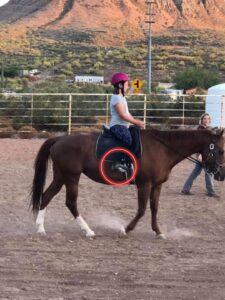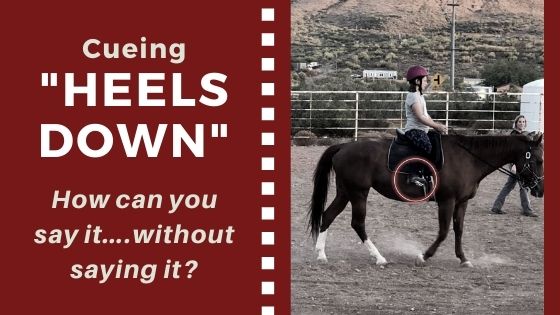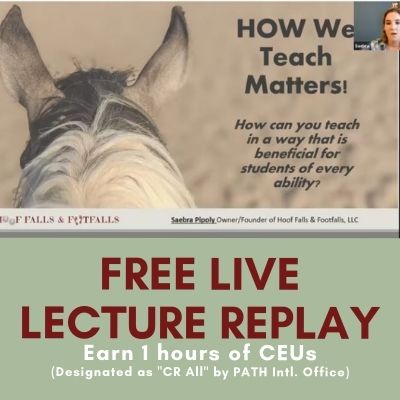How can you say it….without saying it?

Did you know that traditional cues like “heels down” that focus on a body part (internally focused cues) are hard for our brains to process and often create other unintended side effects as well?
Cueing HEELS DOWN without saying “heels down”:
- “Heavy boots”- Usually creates a direct downward flat foot or slight heel drop.
- “Drag your boots in the dirt”- Good for riders that like to toe down, bring their heel behind the hip, and/or don’t step enough into the stirrup. Creates a more forward and down movement of the foot.
- “Step your stirrups to your horse’s back hooves”- Good for riders that tend to sit more chair seat, slouchy, and/or heel in front of hip. Creates a more back and down movement of the foot.
- “Squish your stirrups into the sand”- Good for riders that have ok hip/heel alignment but are too light on inner leg on the saddle and foot pressure in the stirrup.
- “Land on the trampoline like your ready for your next bounce”- Usually follows a discussion about what happens if you land on your toes or heels on a trampoline. Good for 2-point or trot work that is more dynamic than halt or walk.
- “Let your boots/stirrups melt down into the sand”- Creates more of a down and in movement of the foot. Good for tense riders that tend to brace in the legs or ankles.
- “Let the tips of your noodles get sandy!”- Creates a lengthening and laying on of the entire leg down to the heel. Helpful for riders that get tense and tend to have inner leg off the saddle as their heels come up and into the horse. We have to talk about “noodle legs” first to help frame this cue. This one also usually gets some laughs as we talk about eating sandy noodles.
Click Here for a FREE online course on cueing and maximizing communication?
Want to learn more about external vs. internal focused cuing? Check out this FREE presentation that counts towards CEUs!
In this presentation, Saebra (HF&F) covers key concepts found in the book The Language of Coaching: The Art & Science of Teaching Movement and gives adaptive/therapeutic riding instructors the “how to” apply the information in the next lesson they teach.
WARNING: You may be shocked at the immediate positive outcome you see in your lessons!
What are some of your favorite ways to cue “heels down” without actually saying it?
Other ways to say “HEELS DOWN”- contributed by other fellow instructors
- “Toes up” which seems to produce a lightness in their leg and a better bend in their knee vs. heels down which tends to produce a stiff, tighter leg that sometimes gets pushed forward. (Contributed by Maggie M., Anna R. and several others)
- Fun mental image/feel to go with “Toes up”: I also ask them to imagine a balloon tied to their toes and it’s pulling their toe up to the ceiling (contributed by Tamsin H.)
- “Relax your ankles” (Contributed by Anna R.)
- “Play a piano with your toes!” Can’t free the toes to move, without putting the weight on the balls of the feet, which allows the heel to drop. (contributed by Lottie A.)
- “Let your legs hang like heavy wet noodles”. Heels down especially with my riders who have a lot of tone in their bodies comes from relaxing their pelvis so a lot of cues are given there. Also something about spreading the toes in their sneakers or boots makes the heels sink so I use that one a lot too. (contributed by Kirsten R.)
- “Toes towards your horse’s nose (or ears)” – Depending on the rider’s height/leg length. It doesn’t make sense for some young riders if their legs aren’t long enough compared to the horse’s head. (Thank you to Maggie M. and Heather C. for the contribution)
- I like to tell riders to feel the weight of their leg run into the heel. Or a slightly different approach for those who have good awareness of subtle movements and body parts, have them “lift the arch”. Same effect as ‘heel down’ but it also helps engage the pelvic floor. (contributed by Michelle L.)
- “Toes towards the sky” (Contributed by Jam T., Tabitha H., and several others)
- “Relax your ankle, relax your grip and press down into your heel” Explain frictional grip as opposed to muscular grip to allow the weight to go to your heel, which acts as an anchor. (contributed by Sue S.)
- I’ll have a little pre-ride a discussion about the length of their shin and the length of their calf. Then I talk about how the back of their calf could be like rubber bands while the front of their leg, their shin is more like a stick. If I need a subtle adjustment I’ll verbally queue them to stretch the rubber bands in the back of their calf, or to make the back of their leg longer than the front of their leg to drop their heel down. (contributed by Kaye H.)
- “Happy toes and grumpy toes” I use happy toes and grumpy toes and make a game. My riders love it. (contributed by Genie H.)
Activities to help with heels down and enhance verbal cues– contributed by other instructors
- Rings on toes– I’ve also put rings on their toes and challenged them to not let the rings fall. (contributed by Maggie M., Jennifer M., and several others)
- On occasion I would have them put their heel on the stirrup so they could feel the weight a little better (but not for too long because you can get a bad rub on the back of your ankle). Practice standing straight up on your toes with ankle, knee and hip angles open and then sliding down into the correct leg position to balance over your leg (at halt, and then at walk. (contributed by Sue S.)

This page contains Amazon Affiliate Links. I earn a small commission off any products purchased through my affiliate links. This commission goes right back into HF&F to help offset the time, money, and resources it takes to creating free and low-cost EAS Industry Instructor education! Thank you for your purchases though my links!



